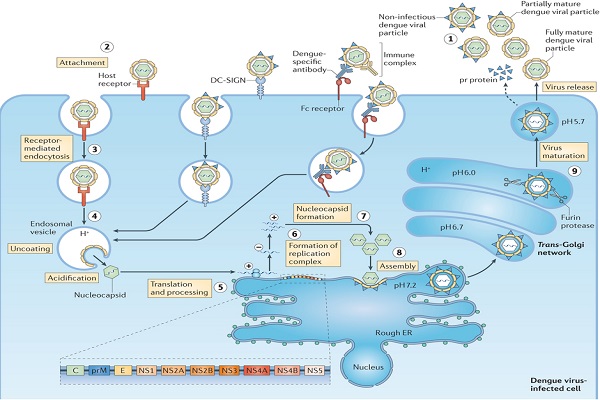Replication of Dengue Virus
Replication of Dengue Virus

Dengue Virus enters host cells by receptor-mediated endocytosis, which involves binding through the interaction between the surface proteins of virion (E) and cellular receptors on the surface of target cell. Once the virus has entered a host cell, the virus penetrates deeper into the cell and remains inside the endosome. Two conditions are needed for the dengue virus to exit the endosome which are:
- The endosome must be deep inside the cell where the environment is acidic and
- The endosomal membrane must gain a negative charge.
These conditions allow the virus envelope to fuse with the endosomal membrane, releasing the dengue nucleocapsid in the cell cytoplasm and the nucleocapsid uncoated to release viral genome. The viral genome act as mRNA and is translated into polyprotein at rough endoplasmic reticulum by viral and cellular proteases. Non-structural proteins replicate the viral RNA. Viral replication occurs in two steps, first the positive-mRNA is copied to negative sense RNA, which, in turn, serves as a template for the synthesis of multiple strands of positive sense RNAs. Then the positive-sense RNA can be used for translation. Virus assembly occurs at the endoplasmic reticulum (ER) membrane, where C protein enclose the newly synthesized vRNA, forming nucleocapsid. The nucleocapsids are enveloped by the ER membrane and glycoproteins to form immature virus particles. Finally, immature virus particles travel in vesicles to the Golgi apparatus where they undergo glycosylation and in the acidic environment of the trans- Golgi network (TGN), furin-mediated cleavage of prM in M generates maturation of the virus. Mature virus is released from the cell by exocytosis.
In secondary infection with a heterologous serotype, which reportedly leads to more severe disease, Antibody dependent enhancement (ADE) can mediate virus attachment and uptake. The ADE model postulates that non-neutralizing antibodies can interact with the DENV and facilitate viral entry into monocytes and macrophages via Fc receptors. However DEN-2 may enter human peripheral blood monocytes by direct fusion with the plasma membrane. DENV has been shown to infect numerous cell lines in vitro including endothelial cells, B and T cells, and hepatocytes. However one important target cell type for DVI in Vivo is cell of monocyte lineage.
References
- Iglesias NG, Byk LA and Gamarnik AV. 2014. Molecular Virology of Dengue Virus. CBA International. 334-354.
- Alcaraz-Estrada SL, Yocupicio-Monroy M, Angel RM. 2010. Insights into dengue virus genome replication. Future Virol. 5(5): 575–592.
- Dengue viruses. http://www.nature.com/scitable/topicpage/dengue-viruses-22400925
- Tuiskunen A and Lundkuist A (2013). Dengue viruses an overview. Infection ecology and Epidemiology. 3: 19839.
- Watowich S, Malmstrom R. and Tomlinsons S (2009). New approaches to structure – based discovery of dengue protease inhibitors. Infect Disorders – Drug Targets. 9(3)
- Wati S, Li P, Burrel C and Carr J (2007). Dengue virus (DENV) replication in monocyte derived macrophages is not affected by tumor necrosis factor alpha (INF-α) and DENV infection induces altered responsive to TNF-α stimulation. J. Vital. 81: 1011-1071.